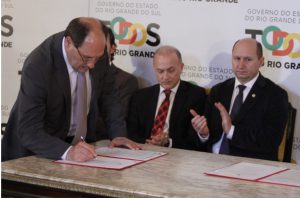. . DEMOCRATIC PARTICIPATION . .
An article by Suzy Scarton in the Jornal de Comércio (translated by CPNN)
Although innovative, the practice is simple. Restorative justice aims to deal with violations by put ting the victim and aggressor face to face, so that the latter can reflect on the damage caused to the first. The initiative, already deployed in the capital and in some cities, such as Caxias do Sul and Santa Maria, became statewide on the afternoon of Thursday [October 13]. At the Piratini Palace, the heads of the Executive, the Judiciary, the Legislature, the Public Ministry and the State Public Defender signed a protocol that allows the Rio Grande do Sul to seek social peace by this means.

The protocol development is an initiative of the State Court
JONATHAN HECKLER / JC
The protocol sets out four lines of action: promoting actions of social mobilization and dissemination of culture, promoting the restorative approach and the culture of peace, training human resources to apply the concepts of restorative mode, as well as the implementation of programs related to it. The first task of the Executive Committee responsible for the implementation of the methodology will relate to activities that are already being developed.
Precursor of this method in the state, the judge Leoberto Brancher, of the Children and Youth Regional Juvenile Court in Caxias do Sul, explains that the restoration plans to solve crimes and conflicts based on dialogue and accountability. “It places an emphasis not on the discussion of laws, but of people and relationships in order to repair the consequences of these problems,” he explains. Since the Court, the Legislative Assembly, the Ministry of Justice and the Public Defender’s Office are involved in the project, Brancher believes that all services will be united in the resolution of conflicts which would otherwise go to the judiciary.
(article continued in right column)
Restorative justice, What does it look like in practice?
(article continued from left column)
In practice, restorative justice can work with or without the involvement of the victim. “The victim has been damaged. Instead of using punishment, we propose a constructive action: the offender needs to implement a compensation plan for the damage that was caused,” says the magistrate. The victim may prefer not to participate, in which case the alternative is to involve family members and people involved in the community to which the offender belongs. “There are cases where we end up with a family strengthening circle, to strengthen ties.” The judge hearing the case can even suspend it until a compensation plan is drawn up. If it is considered adequate, the judge can decide that the compensation plan is implemented instead of the sentence.
Brancher adds, however, that the success of the method depends on the training of a facilitator, since the work must be done face to face. “The measure has preventative efficacy. We have a thousand facilitators trained in Caxias do Sul to work on prevention. Then we form a group to resolve conflict situations,” said the magistrate. In addition to avoiding conflicts, the measure also seeks to inhibit recidivism, as it aims to strengthen the adhesion of the subject to compliance with a socially acceptable conduct. “The intention is to follow offenders without their being sentenced. They are pressured to recognize its value, as people close to them are witnessing and charging them,” he explains.